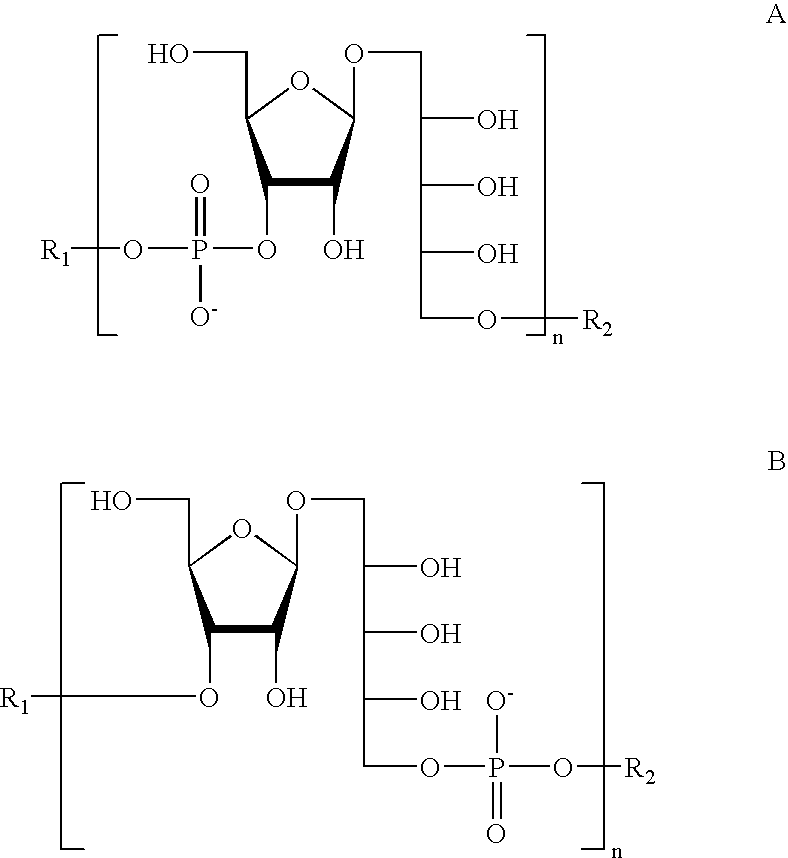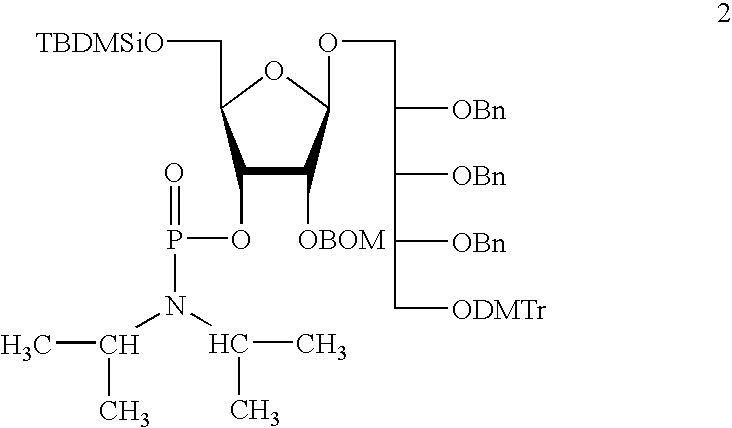Oligosaccharides derived from ribose-ribitol-phosphate, and vaccines containing them
- Summary
- Abstract
- Description
- Claims
- Application Information
AI Technical Summary
Problems solved by technology
Method used
Image
Examples
example 1
Synthesis of 5-O-allyl-2,3-di-O-benzyl-D-ribitol 11
Allylation.
100 g of methyl 2,3-O-isopropyliden-D-ribofuranoside were dissolved in 70 mL of allyl bromide and stirred in the presence of 75 mL of aqueous sodium hydroxide 50% and 2.6 g of tetrabutyl ammonium iodide during 12 hours. After this time, the stirring was stopped and the phases were separated. The aqueous phase was extracted with dichloromethane (70 mL) and the pooled organic phase was dried and evaporated.
The resulting syrup was dissolved in 1.5 L of methanol. To this solution were added 3.6 mL aqueous sulfuric acid (0.4 N) and the mixture was refluxed for 3 hours. After the reaction finished, it was neutralized with sodium bicarbonate, the resulting salts were filtered and the solution was evaporated. The residue was extracted with ethyl acetate, dried and evaporated. The product was dried in vacuum for at least 2 hours.
Benzylation.
The product obtained was dissolved in 450 mL of dimethylformamide. The resulting...
example 2
Purification of 5-O-allyl-2,3-di-O-benzyl-D-ribitol 11
To the dichloromethane solution of crude 5-O-allyl-2,3-di-O-benzyl-D-ribitol 11 from the previous example were added 300 g of silicagel and the mixture was stirred manually until the product was adsorbed in the solid phase. The suspension was evaporated in vacuum for the elimination of dichloromethane. The silicagel containing the product was placed in a percolator. The impurities were removed by extraction with cyclohexane for 48 hours. The solvent of extraction was change to dichloromethane for the extraction of the product giving a chromatographically pure pale yellow syrup. Yield 75-95%. NMR.sup.13 C .delta. 60.7(C-1), 70.2 (C-4), 71.0, 71.7, 72.0, 73.6 (PhCH.sub.2 C-5, OCH.sub.2 CH.dbd.), 79.2, 79.3 (C-2,3), 117.1 (CH.sub.2.dbd.), 127.5-128.2 (Ph), 134.3 (CH.dbd.), 138.0, 138.1 (Cipso).
example 3
Synthesis of 5-O-allyl-2,3,4-tri-O-benzyl-D-ribitol 14
Trytilation.
100 g of 5-O-allyl-2,3-di-O-benzyl-D-ribitol 11 from the previous example were dried in vacuum and dissolved in 600 mL of pyridine. To this solution were added 75 g of chlorotriphenylmethane and 0.5 g dimethylaminopyridine and the mixture was stirred at 50.degree. C. for 6 hours. Once the reaction is finished, the solvent was evaporated and the residue was dissolved in 500 mL of dichloromethane, the solution was washed with water (1 L), dried and evaporated. The residue was dried in vacuum for 3 hours.
Benzylation.
The syrup from the previous reaction was dissolved in 300 mL of dimethylformamide and the solution was cooled to 5.degree. C. Sodium hydride (25 g) was added slowly and the stirring was then continued for 30 minutes. Benzyl chloride (40 mL) was then added slowly and the stirring was maintained for 1 hour. After the reaction have finished, it was cooled again and 10 mL of methanol were slowly added in order to...
PUM
| Property | Measurement | Unit |
|---|---|---|
| Structure | aaaaa | aaaaa |
| Molar ratio | aaaaa | aaaaa |
Abstract
Description
Claims
Application Information
 Login to View More
Login to View More - R&D
- Intellectual Property
- Life Sciences
- Materials
- Tech Scout
- Unparalleled Data Quality
- Higher Quality Content
- 60% Fewer Hallucinations
Browse by: Latest US Patents, China's latest patents, Technical Efficacy Thesaurus, Application Domain, Technology Topic, Popular Technical Reports.
© 2025 PatSnap. All rights reserved.Legal|Privacy policy|Modern Slavery Act Transparency Statement|Sitemap|About US| Contact US: help@patsnap.com



